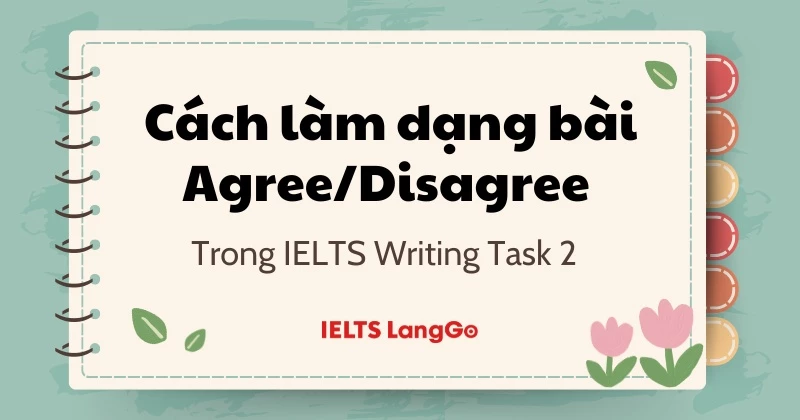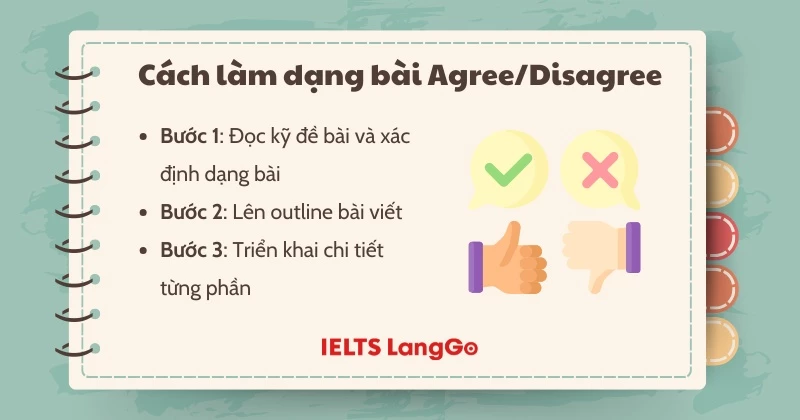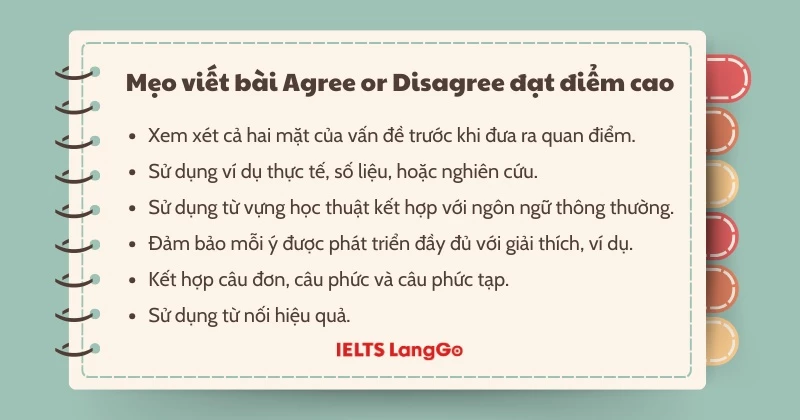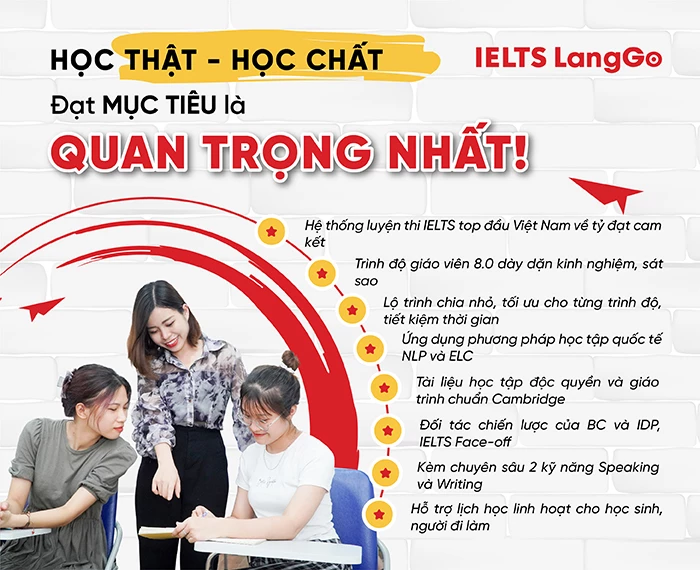



Dạng writing task 2 agree or disagree là một trong những dạng bài phổ biến nhất trong kỳ thi IELTS Writing. Bài viết này sẽ giúp bạn nắm vững cấu trúc, phương pháp tiếp cận và chiến lược làm bài hiệu quả cho dạng bài này. Cùng tham khảo nhé!
Dạng bài agree or disagree trong IELTS Writing task 2 là dạng bài yêu cầu thí sinh bày tỏ quan điểm đồng ý hay không đồng ý với một ý kiến, quan điểm hoặc phát biểu được đưa ra trong đề bài.
Các cách diễn đạt thường gặp của dạng bài này bao gồm:
Dạng bài writing task 2 agree or disagree đòi hỏi thí sinh phải thể hiện quan điểm rõ ràng và xây dựng lập luận thuyết phục. Hãy tham khảo quy trình làm bài từ phân tích đề bài đến cách triển khai từng phần cụ thể sau đây nhé:

Đầu tiên, bạn cần đọc đề và phân tích kỹ yêu cầu của để bài để nhận dạng:
Thông thường, đề bài agree/disagree có cấu trúc như sau:
Câu giới thiệu chủ đề chung
Một quan điểm/ý kiến cụ thể
Câu hỏi yêu cầu bạn đồng ý hay không đồng ý
Ví dụ: Đề bài: "Many people believe that international tourism produces more problems than benefits. To what extent do you agree or disagree?" (Nhiều người tin rằng du lịch quốc tế gây ra nhiều vấn đề hơn lợi ích. Bạn đồng ý hay không đồng ý ở mức độ nào?)
Phân tích:
Sau khi hiểu rõ đề bài, bạn cần quyết định quan điểm của mình. Có ba hướng tiếp cận chính:
Đồng ý hoàn toàn (Completely agree): Bạn hoàn toàn ủng hộ quan điểm được đưa ra
Không đồng ý hoàn toàn (Completely disagree): Bạn hoàn toàn phản đối quan điểm được đưa ra
Đồng ý một phần (Partly agree): Bạn đồng ý với một số khía cạnh nhưng không đồng ý với các khía cạnh khác
Việc chọn quan điểm nào không ảnh hưởng đến điểm số, miễn là bạn phát triển lập luận thuyết phục và nhất quán. Tuy nhiên, với nhiều đề bài, lập trường "đồng ý một phần" (Partly agree) thường cho phép bạn phát triển lập luận sâu sắc và đa chiều hơn.
Sau đó, hãy dành 2-3 phút để brainstorming các ý tưởng cho bài viết và lập ra outline cho bài viết đó. Sau đây là cấu trúc bài viết của 3 hướng tiếp cận phía trên mà bạn có thể tham khảo:
Introduction (Mở bài):
Body Paragraph 1 (Thân bài 1):
Body Paragraph 2 (Thân bài 2):
Conclusion (Kết bài):
Cấu trúc tương tự như bài viết đồng ý hoàn toàn, nhưng quan điểm và luận điểm ngược lại:
Introduction (Mở bài):
Body Paragraph 1, 2: Tương tự cấu trúc trên, nhưng nội dung thể hiện sự không đồng ý
Conclusion (Kết bài): Tái khẳng định lập trường không đồng ý và tóm tắt lại các luận điểm
Đây thường là cách tiếp cận phức tạp nhất nhưng cũng cho phép bạn thể hiện sự suy nghĩ đa chiều và tinh tế:
Introduction (Mở bài):
Body Paragraph 1 (Thân bài 1):
Body Paragraph 2 (Thân bài 2):
Body Paragraph 3 (Tùy chọn):
Conclusion (Kết bài):
>> Xem tthêm: Hướng dẫn trả lời Partly Agree cho dạng bài Agree Disagree IELTS
Sau khi đã có dàn ý, bạn cần triển khai chi tiết từng phần theo một trong ba cách sau:
Cấu trúc câu nên dùng:
Từ nối/chuyển ý phù hợp:
Cấu trúc câu nên dùng:
Từ nối/chuyển ý phù hợp:
Cấu trúc câu nên dùng:
Từ nối/chuyển ý phù hợp:
Cùng với những thông tin trên, các bạn có thể tham khảo video Hướng Dẫn Chi Tiết Writing Task 2: Agree Or Disagree mà LangGo chia sẻ dưới đây để hiểu rõ hơn về cách làm dạng bài này nhé.
Khi làm dạng writing task 2 agree or disagree, việc áp dụng các chiến lược viết hiệu quả sẽ giúp bạn xây dựng bài viết thuyết phục và đạt điểm cao. Dưới đây là những chiến lược quan trọng nhất bạn nên áp dụng:

Dưới đây là ba bài mẫu cho dạng writing task 2 agree or disagree với band điểm cao. Bạn hãy tham khảo để biết cách viết cụ thể nhé:
Đề bài: Some people believe that university education should focus on preparing students for the job market rather than providing general knowledge. To what extent do you agree or disagree?
Phân tích đề bài: Đề bài yêu cầu thảo luận về mục đích của giáo dục đại học: liệu nên tập trung vào chuẩn bị cho thị trường việc làm hay cung cấp kiến thức tổng quát. Tôi cần bày tỏ quan điểm về mức độ đồng ý/không đồng ý với ý kiến này.
Bài mẫu:
In an increasingly competitive global economy, the purpose of higher education has become a subject of debate. Some argue that universities should prioritize job market preparation over general knowledge acquisition. I completely agree with this perspective for several compelling reasons.
Firstly, the primary motivation for most students pursuing university education is to secure gainful employment. The substantial investment of time and money in obtaining a degree is justified primarily by improved career prospects. When universities focus on workplace skills, they directly address this fundamental need. For example, programs incorporating internships, industry projects, and practical training consistently produce graduates who transition more smoothly into professional roles. The success of cooperative education models at institutions like Waterloo University in Canada, where students alternate between academic terms and paid industry placements, demonstrates the effectiveness of this approach.
Secondly, the rapid evolution of technology and business practices demands job-specific skills that general knowledge alone cannot provide. Graduates equipped with specialized technical competencies and industry awareness are more valuable to employers than those with broad theoretical understanding but limited practical abilities. Consider the field of computer science, where knowledge of specific programming languages, development methodologies, and cybersecurity protocols is far more relevant to immediate employability than a general understanding of computing theory.
In conclusion, while general knowledge has its place, I firmly believe universities should prioritize job market preparation to fulfill their primary role in modern society. This approach not only meets students' expectations and needs but also responds to the demands of the contemporary economy while still developing transferable intellectual abilities.
Đề bài: Some people think that the best way to reduce crime is to give longer prison sentences. Others, however, believe there are better alternative ways of reducing crime. Discuss both views and give your opinion.
Phân tích đề bài: Đề bài yêu cầu thảo luận về hai quan điểm khác nhau về cách giảm tội phạm: một là tăng thời gian phạt tù, hai là các biện pháp thay thế. Tôi cần thảo luận cả hai quan điểm và đưa ra ý kiến cá nhân.
Bài mẫu:
There is ongoing debate about the most effective approach to crime reduction in society. While some advocate for extended incarceration periods, others propose alternative strategies. I completely disagree with the notion that longer prison sentences are the optimal solution and believe other methods offer more sustainable results.
Proponents of increased prison terms argue that extended incarceration serves as a powerful deterrent. They contend that the prospect of spending decades behind bars discourages potential offenders from engaging in criminal activity. Additionally, longer sentences keep dangerous individuals isolated from society, theoretically preventing them from committing further crimes during their confinement. Countries like the United States have implemented such policies, with some states mandating "three strikes" laws that impose lengthy sentences for repeat offenders.
However, I firmly believe alternative approaches are significantly more effective. Rehabilitation programs that address the root causes of criminal behavior – such as substance abuse, mental health issues, and lack of education – show consistently better outcomes in reducing reoffending rates. For instance, Nordic countries like Norway focus on rehabilitation rather than punishment, resulting in recidivism rates around 20% compared to over 40% in countries emphasizing punitive measures. These programs equip offenders with skills and support systems necessary for successful reintegration into society.
In conclusion, while longer prison sentences might temporarily remove offenders from society, they fail to address the underlying causes of criminal behavior and often exacerbate problems upon release. I strongly believe that rehabilitation programs and preventative social measures represent more effective, humane, and economically sensible approaches to creating safer communities.
Đề bài: Some people believe that children should be allowed to watch whatever they want on television and the internet, while others think parents should strictly control what their children are exposed to. Discuss both views and give your opinion.
Phân tích đề bài: Đề bài yêu cầu thảo luận về hai quan điểm trái ngược về việc trẻ em nên được tự do hay bị kiểm soát khi tiếp cận nội dung trên TV và internet. Tôi cần thảo luận cả hai quan điểm và đưa ra ý kiến cá nhân.
Bài mẫu:
The debate over children's access to digital content has intensified in our increasingly connected world. While some advocate for unrestricted access, claiming it fosters independence, others insist on strict parental oversight to protect young minds. I partially agree with both perspectives, believing that a balanced approach combining reasonable supervision with age-appropriate freedom is most beneficial.
Those supporting unrestricted access argue that exposure to diverse content develops critical thinking skills and media literacy. They suggest that children naturally gravitate toward age-appropriate material when given freedom, and learning to navigate digital spaces independently prepares them for adulthood in a technology-driven society. Additionally, proponents contend that excessive restrictions may simply drive children to access prohibited content secretly, potentially in less safe environments. Research from digital education specialists indicates that children who develop independent media selection skills early often demonstrate better self-regulation with technology as teenagers.
Conversely, advocates for strict parental control highlight the genuine risks of unrestricted access. Young children lack the cognitive development to distinguish between appropriate and harmful content, potentially exposing them to violence, explicit material, or predatory individuals. Studies by child psychologists have linked early exposure to violent media with increased aggression and desensitization. Furthermore, excessive screen time without parental guidance can displace important developmental activities like physical play, face-to-face social interaction, and academic pursuits.
I believe the most effective approach combines elements from both perspectives, adapting as children mature. For younger children, active parental oversight is essential, utilizing child-friendly platforms and age-appropriate content filters. However, this supervision should gradually transition toward guided independence as children demonstrate responsibility. Parents should engage in ongoing conversations about digital citizenship, critical media evaluation, and online safety rather than simply imposing restrictions. For example, co-viewing programs with younger children and discussing content critically, then gradually allowing more autonomy with check-ins for teenagers represents an evolving approach that respects development.
In conclusion, while I acknowledge valid concerns from both perspectives, I believe neither complete freedom nor rigid control serves children's best interests. A thoughtful progression from guided exploration to monitored independence adjusted to each child's maturity and circumstances—best prepares young people for our digital world while protecting their wellbeing.
Như vậy, IELTS LangGo đã hướng dẫn bạn cách viết dạng bài Agree or Disagree essay trong Writing Task 2, đồng thời cùng bạn tham khảo một số bài mẫu để bạn có thể hiểu rõ hơn cách làm dạng bài này. Hãy thực hành thường xuyên và áp dụng những mẫu câu, cấu trúc đã học để ngày càng hoàn thiện kỹ năng viết của mình bạn nhé!



ĐẶT LỊCH TƯ VẤN MIỄN PHÍ LỘ TRÌNH Săn ƯU ĐÃI lên tới 12.000.000đ